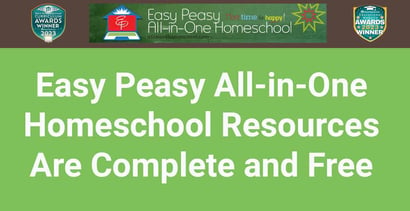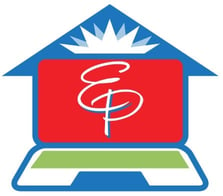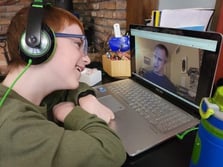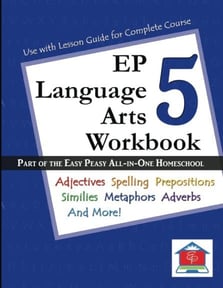
In a Nutshell: More families than ever are interested in home-schooling, especially since the COVID-19 pandemic. Online resources abound but tend to be incomplete and restricted in cost and access. Easy Peasy All-in-One Homeschool (EP) provides a free and complete pre-K to 12th-grade curriculum lovingly curated by a home-schooling parent. EP is Christian-centered, but it includes all core school subjects, and many seeking non-theological instruction use it. Families worldwide turn to EP for straightforward access to comprehensive and affordable resources that make the benefits of home-schooling accessible to everyone.
Lee Giles knows a girl who earned a full college scholarship to study art at 17. Evaluators noted that her work evidenced long hours honing her skills even at her relatively young age.
She had time to connect with her talent and practice her art because she had been home-schooled through Easy Peasy All-in-One Homeschool (EP), a comprehensive free curriculum Giles developed. Instead of spinning her wheels pursuing generic coursework in classrooms, she learned to take control of her education and channel her passions.

For example, although she did not have an affinity for science, she studied light and anatomy in the context of artistic expression, learning about physics and the body along the way.
It’s a personal example of how home-schooling can transform young people from passive participants in their learning into independent, self-motivated thinkers, Giles said. By helping children discover what they love about learning, home-schooling can inspire self-actualization and overcome notions of performance and competition prevalent in hyper-social classroom environments.
Tens of thousands of parents and children worldwide choose Christian-centered Easy Peasy All-in-One Homeschool to help their children learn more about who they are as members of their families.
“The biggest thing we hear is that coming home frees kids from the anxiety and the bullying in school and can really change their lives,” Giles said. “And kids with learning disabilities like dyslexia sometimes spend those first years thinking they’re stupid because they haven’t gotten reading down. All of a sudden, once they were home, they get A’s because they learned they aren’t dumb, they got attention, and they got to focus on their strengths while working on reading at their own level and pace.”
A Comprehensive Platform With Proven Curricular Benefits
Not that EP is a walk in the park — far from it. Parents and children have gravitated to it because it’s a one-stop learning shop. In a home-schooling marketplace where piecemeal resources and paywalls are the norm, EP is the real deal.
“Our mission is to make home-schooling possible even when you feel you lack the time, money, or know-how,” Giles said. “If you want it to happen, you can make it happen.”
All EP instructional materials are offered free to a worldwide audience. My EP, a web app for lesson delivery that Giles built after participating in a coding class, is free. There are no ads on the site.

Make no mistake: Giles and her family are Christian, and EP presents Bible-focused studies, including workbooks for sale for families who prefer offline learning. Textbooks, workbooks, and printables are available in the EP Store. EP also receives financial support through donations.
“The reason it’s free is because it’s Christian — I had a conviction in my heart not to charge for it,” Giles said. “When I talk about finances, I’m talking about faith.”
Although most of EP’s audience is Christian (true of US home-schoolers in general), others access the site without using biblical material. The platform serves pre-K through 12-grade learners, provides instruction in all core subjects, including physical education/health, music, and art, and guides US parents in meeting educational requirements in their state.
Placement guides help parents orient their children progressively within each subject. An extensive section of frequently asked questions explains the platform and various issues about home-schooling. Giles said the advantages go well beyond subjective.
“There’s a definite statistical benefit — the bell curve for test scores shifts upward when you home-school,” she said. “It doesn’t mean there aren’t kids at the bottom, but the whole thing just shifts.”
Children Learn Independently in a Nurturing Environment
EP came about due to decisions Giles made on her own family’s home-schooling journey. As she compiled online resources, placing them on a family website with public access, she intentionally presented the material to speak to a broader audience.
“And that was the end of that — as people found the site, they spread the word,” Giles said.
Her strategy was to create an environment in which her children could learn independently. At the time, the family lived overseas as missionaries, and her responsibilities extended to frequently welcoming visitors into her home. There wasn’t time to play teacher.

“I needed them to be able to just do their work,” she said.
That goal speaks to a debate both within and outside the home-schooling community about the relative benefits compared to conventional classroom instruction.
Giles said the most common argument against home-schooling is that a home learning environment cannot provide the necessary socialization. Home-schoolers point out that classroom students are supposed to sit quietly at their desks, and when they do manage to socialize, perhaps between classes, they do it solely within their peer group.
“There’s not a lot of diversity in that,” Giles said.
However, home-schoolers don’t stay in their homes all the time. There are many opportunities for outside cooperative learning, and kids can get involved in more activities because they’re not stuck in school all day.
“Home-school kids are much more used to being around children of different ages and interacting with adults,” Giles said. “They’re used to guiding their education, not being force-fed — they have to be proactive and get through learning themselves.”
Supporting a Worldwide Home-schooling Community
Since the early days of Giles building web links to materials she found online, EP has continued to grow in scope and outreach. Over time, Giles and a small cohort of dedicated volunteers have developed worksheets and other materials to combat link loss.
“The more we develop our own stuff, the easier it is for us,” Giles said. “We have people who work on developing workbooks as well as online learning games for the curriculum.”

The home-schooling community also pitches in, mainly using Facebook as a resource for connection and communication. A central Facebook site connects to a private user support group where volunteers stand ready to answer questions, address concerns, and receive corrections and additions to the material.
There’s also a private general chat group and a slew of Facebook communities organized by state, country, educational level, theme, special-needs children, Spanish speakers, and much more — all emanating from the mind, heart, and dedication of one mother who wanted to teach her children something special.
“I’m not the one with the knowledge,” Giles said. “My gift is in organizing the information — that’s my talent.”
The site has taken on a life of its own through the volunteers who help Giles maintain it and the Facebook users who gather in support. The watchword is always affordability. Texts and worksheets are available for sale, but families worldwide, including in Africa, can access the site via cellphone and handle the lessons without printing or purchasing anything.
The curriculum changes, too, fueled by volunteer support and Giles’ continued efforts. Meanwhile, the 17-year-old artist was thrilled when she entered college. There was none of the jaded attitude the parents of so many conventionally educated children routinely deal with.
“She was like, yay, it’s classes, while other students moaned at the start of a new year,” Giles said. “She never learned to hate school.”






